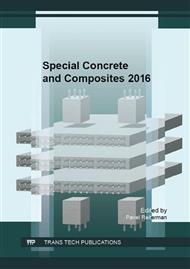[1]
T.C. Hansen, Recycling of Demolished Concrete and Masonry, E&FN Spon, London, (1992).
Google Scholar
[2]
K. McNeil, T. H-K. Kang, Recycled concrete aggregates: A review, International Journal of Concrete Structures and Materials, 7, 1 (2013) 61-69.
Google Scholar
[3]
R.V. Silva, J. De Brito, R.K. Dhir, Properties and composition of recycled aggregates from construction and demolition waste suitable for concrete production, Construction and Building Materials, 65 (2014) 201-217.
DOI: 10.1016/j.conbuildmat.2014.04.117
Google Scholar
[4]
B. Zając, I. Gołębiowska, Evolution of technology of concrete recycling, Inżynieria i Aparatura Chemiczna, 49, 5 (2010) 134-135, (in Polish).
Google Scholar
[5]
W. Kubissa, R. Jaskulski, A. Koper, M. Supera, High performance concrete with SCM and recycled aggregate, Key Engineering Materials, 677 (2015) 233-240.
DOI: 10.4028/www.scientific.net/kem.677.233
Google Scholar
[6]
M. Koper, The possibility of using of concretes with aggregate from recycled rubble. in: A. Dzięgielewski (Ed. ) Problemy naukowo-badawcze budownictwa, Płockie Forum Budowlane 2010, Płock 2010, (in Polish).
Google Scholar
[7]
A. Ajdukiewicz, A. Kliszczewicz, Influence of recycled aggregates on mechanical properties of HS/HPC. Cement and Concrete Composites, 24, 2 (2002) 269-279.
DOI: 10.1016/s0958-9465(01)00012-9
Google Scholar
[8]
G. Andreu, E. Miren, Experimental analysis of properties of high performance recycled aggregate concrete, Construction and Building Materials, 52 (2014) 227-235.
DOI: 10.1016/j.conbuildmat.2013.11.054
Google Scholar
[9]
W. Kubissa, R. Jaskulski, J. Szpetulski, Properties of Concretes with Natural Aggregate Improved by RCA Addition, Procedia Engineering, 108 (2015) 30-38.
DOI: 10.1016/j.proeng.2015.06.116
Google Scholar
[10]
B. Sadowska-Buraczewska, Kruszywa z recyklingu w budownictwie, Inżynieria Ekologiczna, 40 (2014) 74-81, (in Polish).
Google Scholar
[11]
P. Lovato, E. Possan, D. Dal Molin, A. Masuero, J. Ribeiro, Modeling of mechanical properties and durability of recycled aggregate concretes, Constr. Build. Mater., 26 (2012) 437-447.
DOI: 10.1016/j.conbuildmat.2018.09.018
Google Scholar
[12]
F. Khademi, S.M. Jamal, Predicting the 28 Days Compressive Strength of Concrete Using Artificial Neural Network. i-Manager's Journal on Civil Engineering 6, 2 (2016): 1.
Google Scholar
[13]
F. Khademi, M. Akbari, S.M. Jamal, Prediction of Compressive Strength of Concrete by Data-Driven Models. i-Manager's Journal on Civil Engineering, 5, 2 (2015): 16.
Google Scholar
[14]
L. Taerwe, S. Matthys et al., Fib model code for concrete structures 2010, Ernst & Sohn, Wiley, (2013).
Google Scholar
[15]
H.S. Müller, I. Anders, R. Breiner, M. Vogel, Concrete: treatment of types and properties in fib model code 2010, Structural Concrete, 14, 4 (2013) 320-334.
DOI: 10.1002/suco.201200048
Google Scholar
[16]
R. Jaskulski, Application of simulation methods in engineering issues, Zeszyty Naukowe. Budownictwo/Politechnika Śląska 93 (2001) 165-174, (in Polish).
Google Scholar


